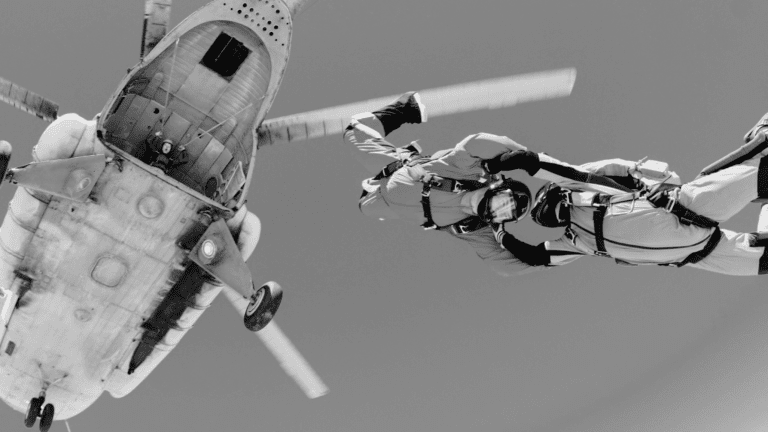FOG OF INNOVATION
Embrace the Unknown: Where Innovation Meets Opportunity
Navigating the Fog of Innovation: Unravelling the Mysteries!
I often get asked how I came up with an idea that is now being used by high-performance teams in both prehospital and hospital environments in many parts of the world. Although the story of how I came across the Idea of SCRAM™ (Structured CRitical Airway Management) is important, the bigger question should be how did we take this idea from its infant spark and navigate it through what I call the fog of innovation, where any turn could have smothered this spark.
The Genesis of SCRAM™:
Every ground-breaking innovation begins as a whisper, a faint idea that, when nurtured, can echo across the world. SCRAM™ was no exception. It was conceived from a moment of insight, a realisation that there was a better way to approach emergency airway management. However, the birth of an idea is merely the prologue to a story laden with challenges and uncertainties.
| “Does it Have to Be That Way?“
The Fog of Innovation:
Picture this journey as a voyage through dense fog. The initial idea, akin to a flickering spark seeking a source of ignition, is enveloped in the fog of innovation. Each step is uncertain, the path not straight but twisting and turning. In the case of SCRAM™, the challenge was not just to protect the spark but to nurture it, allowing it to grow into a blazing fire despite the uncertainties that surrounded its development.
Check out the video below
| “It’s Not Easy “
1. Embracing Uncertainty and Risk:
The path to innovation is not always smooth sailing. There are calm days when it’s essential to pause and take stock of your progress, recharge your batteries, and ensure your compasses are on track. Because the challenges of larger seas are never too far away.
Innovators often find themselves at the crossroads of market acceptance, technological feasibility, and financial viability. The challenge lies in mitigating these risks. For SCRAM™, this meant delving deep into market intricacies, conducting rigorous prototype testing, and embracing agile methodologies. Adapting swiftly became our compass, guiding us through the unknown.
Navigating uncertainty was akin to sailing uncharted waters. We meticulously researched market trends, identified potential pitfalls, and tirelessly tested prototypes. Embracing agile methodologies, we were not afraid to pivot when necessary. Every hurdle was a lesson, and every setback was a stepping stone.
When I presented SCRAM™, I was mindful of the innovation adoption curve, understanding the dynamics of early adopters and those resistant to change. Finding fellow pioneers, we embraced the challenge, knowing that simplicity can often be the key. Feedback, regardless of its nature, was integral to the design philosophy. We fostered an environment where every opinion mattered, creating a vibrant community around the idea of SCRAM™. This collaborative approach transformed barriers into stepping stones, leading us to a human-centred design that can be used as a tool to enhance human performance by reducing cognitive load, time to intervention, and errors during high stakes, high-risk interventions.
| ” ‘Yes, but…’ what does ‘But’ mean – Uncovering the Hidden ‘No’ “
2. Recognising Friction Points and Cultivating Innovation:
Everyone reading this blog has encountered a friction point at some point and possesses a potential solution to address it. These solutions may not always be the “big idea” that revolutionises everything, but often, addressing multiple friction points involves accumulating marginal gains and making significant improvements within the system. An excess of friction points can grind a system to a halt, highlighting the importance of aggregating these smaller ideas, as they may eventually lead to major innovations.
Every organisation encounters challenges, and it’s helpful to view these challenges as “friction points” that can impede a system’s ability to thrive. Some forward-thinking organisations, such as Amazon, have taken proactive steps to address these challenges. Amazon has introduced a concept known as ‘The Institutional Yes,’ a term coined by CEO Jeff Bezos. Under this approach, when a team member presents a suggestion, the initial response should be a resounding ‘Yes.’ If a ‘No’ is necessary, managers are required to provide a comprehensive explanation for their decision. This shift towards prioritising a clear ‘Yes’ over ‘Yes, but…’ which really means ‘No’ aims to foster a culture of exploration and implementation of a wider range of ideas.
For those accustomed to responding with ‘Yes, but…,’ consider embracing the ‘Yes and…’ approach instead. By creating an environment that embraces ideas rather than hiding behind veiled rejections, you can ignite innovation within your organisation. Some have even implemented idea registries to capture and evaluate concepts, recognising that the next Google, Apple, or Amazon might be hidden among these ideas. This proactive approach creates a nurturing environment where ideas and innovation can thrive.

| ” How Many Managers do you Need to Green Light an Idea? “
3. Leveraging Feedback and Collaborative Design:
When I presented SCRAM™, I was mindful of the innovation adoption curve, understanding the dynamics of early adopters and those resistant to change. Finding fellow pioneers, we embraced the challenge, knowing that simplicity can often be the key. Feedback, regardless of its nature, was integral to the design philosophy. We fostered an environment where every opinion mattered, creating a vibrant community around the idea of SCRAM™. This collaborative approach transformed barriers into stepping stones, leading us to a human-centred design that can be used as a tool to enhance human performance by reducing cognitive load, time to intervention, and errors during high stakes, high-risk interventions, such as HALO procedures (High Acuity, Low Occurrence).
For a more comprehensive understanding of HALO procedures, you can explore the following resources:
| ” Navigating the Chasm: Where Purpose Meets Influence, Innovation Thrives“
4. Overcoming Resource Constraints and Expanding Horizons:
Navigating the challenges of limited budgets, time constraints, and a scarcity of expertise could have easily halted our progress. Fortunately, these constraints served as catalysts for creative solutions. Prioritisation emerged as our guiding principle, empowering us to strategically invest in impactful projects. Collaborations with external partners, the outsourcing of non-core tasks, and continuous enhancement of our skills became essential strategies in optimising our resources.
Our strategic approach was underpinned by a deep understanding of the diverse environments where SCRAM™ could create a significant impact: Pre-hospital, Hospital, Military, and Sport. To navigate these complexities effectively, our initial focus was on the Adult cohort within the pre-hospital environment. Concentrating our resources, refining our design, and tailoring methodologies specifically for Adult SCRAM™ enabled us to establish a successful framework underpinned by research. Once validated, we seamlessly transitioned to introduce SCRAM™ into other environments.
Throughout this journey, our community of clinicians played a vital role, providing feedback that profoundly shaped SCRAM™’s evolution. Their input led to the development of specialised variants, including our latest addition to the portfolio, Surgical SCRAM™ – a Brain-Friendly Tool for High-Stakes Surgical Interventions outside the operating theatre. Each iteration of SCRAM™ was born out of the growing demand from our community, guiding us to develop new versions tailored to different parts of the healthcare landscape.
This organic evolution, driven by the needs voiced by our community, laid the foundation for SCRAM™’s global outreach. Penetrating even the discerning market in the United States, our innovation was met with enthusiasm. Recognising the demand for a more compact version, we pivoted once again, leading to the development of Tactical SCRAM™.
In the face of resource constraints, our journey stands as an example of the power of perseverance, innovative thinking, strategic collaboration, and community engagement.

| ” The Power of a Clear Purpose“
5. Confronting Resistance to Change:
Within the corridors of organisations, resistance often lurks, threatening to smother an idea or impede progress. Draw inspiration from Simon Sinek’s profound principle, “Start with Why,” our journey started with a crystal-clear purpose. Our ‘why’ wasn’t merely about creating innovative solutions; it was rooted in a deeper understanding to improve the safety, quality and performance of emergency airway management across the spectrum of age as far and wide-reaching as possible. Starting with such a strong purpose provided a robust foundation, inspiring both our team and stakeholders, as it emphasised the meaningful change we were striving to make.
In the spirit of Daniel Priestley’s ‘The Key Person of Influence,‘ we recognised the transformative power of personal brand and influence. Our initial approach was to identify and engage with key individuals of influence within the medical community. By establishing meaningful connections with these influential figures, we not only gained valuable insights but also garnered support for our innovative concept. These key influencers became our allies and part of the community, passionately advocating for our cause and helping us navigate the complexities of the medical landscape. Their endorsement not only dissolved resistance within organisations but also amplified our message, creating ripples of enthusiasm and belief in our shared vision. In embracing Priestley’s philosophy, we understood that influential individuals possess the ability to catalyse change far beyond their immediate circles, ultimately propelling our idea toward widespread acceptance and impact.
Moreover, Geoffrey A. Moore’s timeless concept of “Crossing the Chasm” played a pivotal role in our strategy. We understood that bridging the gap between early adopters and the mainstream market required a strategic approach. By engaging stakeholders early, understanding their needs, and aligning our innovations with market demands, we effectively crossed the chasm, moving from niche acceptance to widespread adoption.
Through the amalgamation of these principles, we nurtured a culture where resistance transformed into curiosity, scepticism into belief, and barriers into bridges. Our collective vision, grounded in a compelling ‘why,’ transformed not just how we innovated but also how we influenced change. This integration of purpose, influence, and strategic market positioning propelled us forward, shaping not just our innovations but also the landscape of healthcare innovation as a whole.
| “Guardians of Ideas: Bedrock of Innovation in a World of Possibilities”
6. Managing Intellectual Property Concerns:
Navigating the intricate world of intellectual property demands a delicate dance. Legal agreements and a foundation of trust became our safeguards.
In the dynamic realm of innovation, safeguarding your ideas is paramount for long-term success. “Zero to One” by Peter Thiel” offers profound insights into creating unique value in the market, emphasising the strategic importance of intellectual property (IP) for sustainable competitive advantage. Simultaneously, “The Lean Entrepreneur” by Brant Cooper and Patrick Vlaskovits” provides practical guidance on how entrepreneurs can validate ideas efficiently, underscoring the necessity for startups to establish a robust IP strategy from the outset.
These authors illuminate the path forward, emphasising that early attention to intellectual property is not merely a precautionary measure; it’s the bedrock upon which innovative concepts thrive. By safeguarding your creations, you not only protect your ideas but also lay the groundwork for potential collaborations, investments, and market leadership. In the intersection of innovation and protection, a world of possibilities opens up, ensuring your ideas not only flourish but also leave a lasting mark on the landscape of business and creativity.

| “Fusion of Human and AI Creativity”
The Role of AI in Illuminating the Path:
Enter Artificial Intelligence, our beacon in the fog of innovation. Much like a lighthouse piercing through the dense mist, AI shines a light on our path through the innovative unknown. It’s not a magical fix, but a collaborator, working hand-in-hand with human ingenuity. But, of course, this collaboration isn’t without its challenges.
1. AI as a Tool: AI provides invaluable insights, analyses data, and guides decision-making processes. It’s a tool that enables us to uncover hidden patterns, make informed decisions, and innovate with precision.
2. Human-AI Collaboration: Imagine a dance where human creativity and AI move in perfect sync. Each complements the other’s strengths, resulting in a harmonious waltz of innovation. Human creativity provides the spark, while AI’s analytical prowess refines the process, leading to unparalleled possibilities.
| “Fail at Something you Believe in”
Embracing the Future:
As we navigate the fog of innovation, we must recognise that the key lies in this delicate dance between human creativity and AI capabilities. Together, they lead us to limitless possibilities, guiding us through the uncertainties and transforming challenges into opportunities. The future of innovation is not a solitary endeavour but a collaborative fusion, where human ingenuity meets the potential of AI technology.
In this dance between creativity and AI, we find the path forward. As we embrace the fog of innovation, let us remember that within the challenges, within the uncertainties, lies the potential for ground-breaking discoveries.

“Designing For Crisis.”
If you’ve ever faced obstacles while striving to improve things at work, trust me, this episode is an absolute must-listen! 🎧 In this episode, Dan Dworkis, MD, PhD, and I dive into human-centered design principles, cutting through the fog of innovation, and learning to design for what works under pressure. A big thank you to Dan Dworkis, MD, PhD, for having me on the show and facilitating this insightful conversation.
Acknowledgment
The video created in this post represents a fusion of human creativity and AI technology. While the script and creative vision were human-authored, the narration was generated with AI assistance. This innovative collaboration showcases the synergies between human ingenuity and AI capabilities, inviting viewers to explore the unique possibilities that emerge from this partnership.